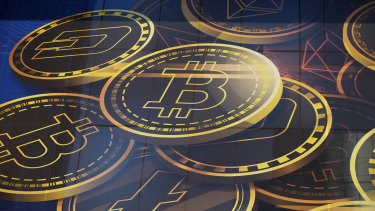There’s a financial joke, whose origin I don’t know, that has been making the rounds lately. It goes like this: If inflation continues at current rates, the purchasing power of wealth held in dollars will be cut in half over the next eight years. But cryptocurrencies can beat that: They can lose half their value in just a few months.
Ha-ha. But crypto enthusiasts have indeed marketed their products as an inflation hedge. Coinbase, the biggest United States crypto exchange, declares that cryptocurrencies are appealing because “they’re more resistant to inflation than fiat currencies like the US dollar.” This is, not incidentally, the same argument people used to make for holding gold.

Why have crypto prices crashed at exactly the moment inflation has taken off?Credit:AP
But a funny thing happened as fears of inflation grew: Bitcoin’s price in US dollars over the past year dropped.
So why have crypto prices crashed at exactly the moment inflation has taken off? To some extent it may be a coincidence: If you believe, as I do, that crypto is to a large extent a Ponzi scheme, this may just happen to be the moment when the scheme has run out of new suckers.
But there’s also a more fundamental issue: People who touted cryptocurrencies as a hedge against fiat-currency inflation — sort of a digital equivalent of gold — fundamentally misunderstood how fiat currency systems work, and also, for what it’s worth, misunderstand what has historically driven the price of gold. It was, in fact, predictable that an upsurge in inflation would drive the price of Bitcoin down — although maybe not that it would produce such an epic crash.
If you believe, as I do, that crypto is to a large extent a Ponzi scheme, this may just happen to be the moment when the scheme has run out of new suckers.
The key point to understand is that while the greenback is indeed a fiat currency — that is, authorities can issue more dollars at will, without the need to back those additional dollars with some kind of collateral — America isn’t Venezuela or the Weimar Republic, a nation that prints money to pay the government’s bills. Our money supply is a policy tool used by the Federal Reserve to help keep prices fairly stable — actually, rising around 2 per cent a year — while avoiding recessions.
Sometimes the Fed gets it wrong, as it did over the past year, when it (and I) failed to see the inflation surge coming. But when it does, it tries to correct the mistake.
What this means, in turn, is that an inflationary outbreak doesn’t presage a spiral of ever-rising prices, which you can avoid by buying crypto. On the contrary, markets believe that the Fed will do whatever it takes to bring inflation back down to normal levels: The five-year, five-year forward inflation expectation rate, a measure derived from spreads between regular US bonds and bonds indexed to the Consumer Price Index, has barely moved through this whole episode.








